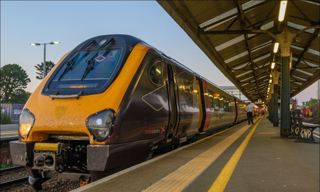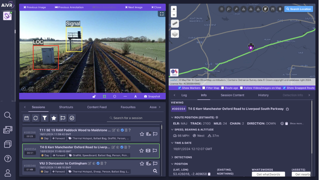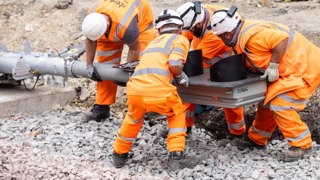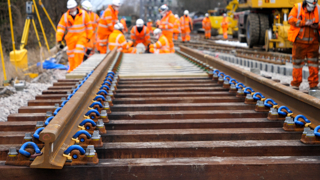‘Inauspicious’ is perhaps one of the politer adjectives that could be used by the 100,000 annual users of Colne railway station to describe the Spartan facilities that await them at the start or end of their journeys.
Nestled in the heart of the Pennines, there is just a single waiting shelter on hand to protect passengers from bad weather, while availing themselves of the hourly local stopping service to Blackpool South (operated by Northern).
Residents of this once heavily-industrialised corner of Lancashire may feel especially aggrieved should they be old enough to recall February 2 1970.
That was the date when the former mill town’s Victorian-built station was largely demolished and degraded to an unstaffed, single-platform affair. It was also the date when through services across the Yorkshire county border to Skipton were unceremoniously ended, and Colne became the outlying terminus of a newly singled and truncated East Lancashire Line running from Gannow Junction at Rose Grove, near Burnley. All this happened despite the entire route having been proposed for retention in Dr Beeching’s infamous 1963 report.
Using slow and unreliable Pacers, this unloved and operationally limited branch line has now come to be seen as something of a dead end, and a poor option for commuters. It’s easy to see why - its infrequent services are timed to take more than 70 minutes to complete the 30-mile journey to Preston, and onward travel to the area’s main employment market in Manchester requires a change at either Accrington or Blackburn, for a journey lasting almost two hours.
With no passing loops, there’s also desperately little scope for recovery from late running, as only one train can access the line at a time.
Following the loss of direct services 46 years ago, passengers for nearby Skipton, Leeds and the rest of West Yorkshire have no alternative than to head west to Accrington, in order to access eastbound services on the Calder Valley route. Leeds can be reached this way in the absurdly long time of 2hrs 50mins, with an added 43 minutes for those then changing for a reversal to Skipton.
Other public transport options do exist, but bus services for the short 11½-mile hop over the hills to Skipton are timed to take 42-48 minutes during the day - more than twice the time it used to take by rail.
But while the attractiveness of utilising the iron road has remained unappealing in Colne, less than a dozen miles away residents in the pleasant Yorkshire market town of Skipton have fared much better.
Skipton has 4,000 fewer residents than the 19,000 living in Colne, yet over ten times as many people using its station. Skipton has four platforms accommodating 2-4 trains per hour to Leeds along the electrified Aire Valley Line, plus five services a day to Lancaster, three to Morecambe and six to Carlisle. There is even a single direct service to London King’s Cross each day, operated by Virgin Trains East Coast.
It’s easy, therefore, to see why 75% of commuters in Airedale choose to use rail, while 70% of commuters in East Lancashire travel by car.
With the standard of rail provision in these two towns now so obviously poles apart, economic disparity has unsurprisingly increased at an alarming rate since 1970. While Skipton enjoys low levels of unemployment, Pendle district and other parts of East Lancashire are consistently ranked among the most economically deprived in the UK. The relative health of the adjacent economies is ably reflected in average house prices, which are nearly double in Skipton (£155,000) than in Colne (£84,000).
Colne’s lack of connectivity to the regional economic centres of Manchester and Leeds has been the critical factor in creating these high levels of deprivation, while narrowing the opportunities for economic development by increasing local perceptions of geographic and social isolation.
Improving transport links between the two towns is therefore a ‘no-brainer’, bringing Colne and the 200,000 residents of the wider East Lancashire area to within 20 minutes’ travelling time of Skipton and the employment opportunities of West Yorkshire if direct rail services were restored.
Understandably, this powerful economic and social argument forms the central pillar of the 15-year-old campaign run by Skipton East Lancashire Rail Action Partnership (SELRAP), and its bid to rebuild the 11½-mile line lifted in 1970. To illustrate the dire state of current travel along the corridor, in 2007 the campaign group even ran two charters between Skipton and Colne via existing routes, demonstrating that the 100-mile return trip takes almost five hours to complete with three reversals.
SELRAP’s second argument is the line’s strategic worth, by adding a fourth possible trans-Pennine route between the West Coast Main Line and Leeds, complementing the existing routes via Diggle, Calder Valley and Copy Pit.
Chaired by David Walsh, its membership has climbed to almost 500 individuals and more than 50 affiliated groups and local businesses, as momentum continues to build and the appetite for improved options by rail steadily grows. Importantly, it also claims to have the written support of 120 MPs, 49 MEPs and more than 500 councils.
SELRAP now hopes to gain the attention of Rail North, which is busily updating its existing Long Term Rail Strategy ahead of its expected merger with Transport for the North in 2017, at which time it will also gain devolved powers from the Department for Transport.
Social and economic cohesion aside, the need for a new east-west link in the region has arguably never been so great, especially for freight. Available paths on existing routes are likely to be squeezed if forecasts for a 70% increase in tonnage using the Port of Liverpool by 2030 are proved right, following the recent completion of a £350 million investment in its deep water container handling terminal. Freight traffic will also need somewhere to go if other Rail North projects go ahead as planned to upgrade both the Diggle and Calder Valley routes.
Skipton-Colne could prove attractive to freight for a number of other reasons. It would have the lowest ruling gradient of all the trans-Pennine routes, and could potentially offer a more direct route for established flows such as the three to four biomass trains operated each day by GB Railfreight between Liverpool and Drax power station.
Each train carries up to 1,650 tonnes of fuel for the UK’s largest generator of renewable energy, but currently runs on a circuitous 99-mile route via Northwich, Stockport and Wakefield. Running via Colne would shorten the journey, although further enhancements would need to be made to increase capacity at Farington Junction near Preston on the West Coast Main Line, and to open up new paths on the congested routes into northwest Leeds. The single-track East Lancashire Line already serving Colne would also need significantly upgrading, to enable hourly paths in each direction and to reduce conflicts with any extra passenger services expected to use the new route.
Bolstering SELRAP’s case is the technical ease with which a re-opening could be achieved. The trackbed between Colne and Skipton is largely intact and mostly used as a footpath, indicating the absence of encroachment from surrounding development.
While a couple of bridges and at least one level crossing would need reinstating, the main engineering difficulties are at either end of the route - where the line would need to pass beneath Vivary Way in Colne, and negotiate the Skipton bypass which now intersects part of the formation’s northern reaches.
A report commissioned by SELRAP from consulting engineer Arup in 2013 estimated a base cost for a single-track rebuild of £38m, and £72m for double-track. Publicly it concedes that a realistic figure would be closer to £100m for the single-track option, given the need to factor in other infrastructure required to enhance the existing portion of the line from Colne to Garrow Junction, to build an appropriate number of passing loops, and to make the route a suitable option for freight. This figure does not include electrification, which would in any case be dependent on future decisions being made to energise the Calder Valley route to the south.
The Arup report concluded that the project could modestly expect to achieve a benefit:cost ratio (BCR) of 1.52, based on passenger numbers rising from 414,000 to 620,000 within ten years of opening. It also assumed the opening of intermediate stations at Earby and Craven Parkway, and a half-hourly service delivered by extending Leeds-Skipton services to Rose Grove, where a bay platform would need to be built.
Estimated revenue from running the service was £1.1m per annum at the lower end, and operating costs between £2m-£3m - suggesting it would require some level of ongoing subsidy.
Encouragingly for SELRAP, the BCR rose to as high as 6.5 if demand materialised at 30% above forecast. This does not seem entirely unrealistic, given the increase in demand for rail services experienced nationally since the report was written in 2013, and the actual footfall of other recently reopened lines (such as the Borders Railway, which has comfortably exceeded best estimates).
The implication from SELRAP is clear that it remains a low-risk and low-cost option, particularly when considering the challenging engineering solutions required to build the three times-longer Borders line, including 42 new structures, at a cost of £350m.
Nevertheless, SELRAP seems realistic, and accepts that success requires more than just mounting public support. Its best chance of DfT funding will come from inclusion in Rail North/Transport for the North’s updated Long Term Rail Strategy, which proposes investment priorities across the north of England for when it gains devolved spending powers in 2017. A further option could be to obtain third party funding, as advocated by the Shaw Report in March 2016, although how Network Rail (NR) intends to implement that particular recommendation and accept private investment is still at a fledgling stage.
In any case, NR’s eight-stage Guide to Rail Investment Process (GRIP) requires a sponsor to step forward from local government to bring railway projects forward.
Councils are obviously nervous of committing to cover any operating losses in the current economic climate, when huge budgetary pressures exist elsewhere to protect vital frontline public services. So to force the issue SELRAP hosted a special meeting on January 6 2015, chaired by the DfT and attended by all regional local authorities, Rail North and Network Rail.
This meeting resulted in the formation of an Outputs Definition Group, chaired by Lancashire County Council, that has subsequently produced its own report which makes for positive reading. With the ODC’s support, it will now be fed into Rail North/TfN’s emerging strategy, which we all await with interest - not least in East Lancashire.















Login to comment
Comments
No comments have been made yet.